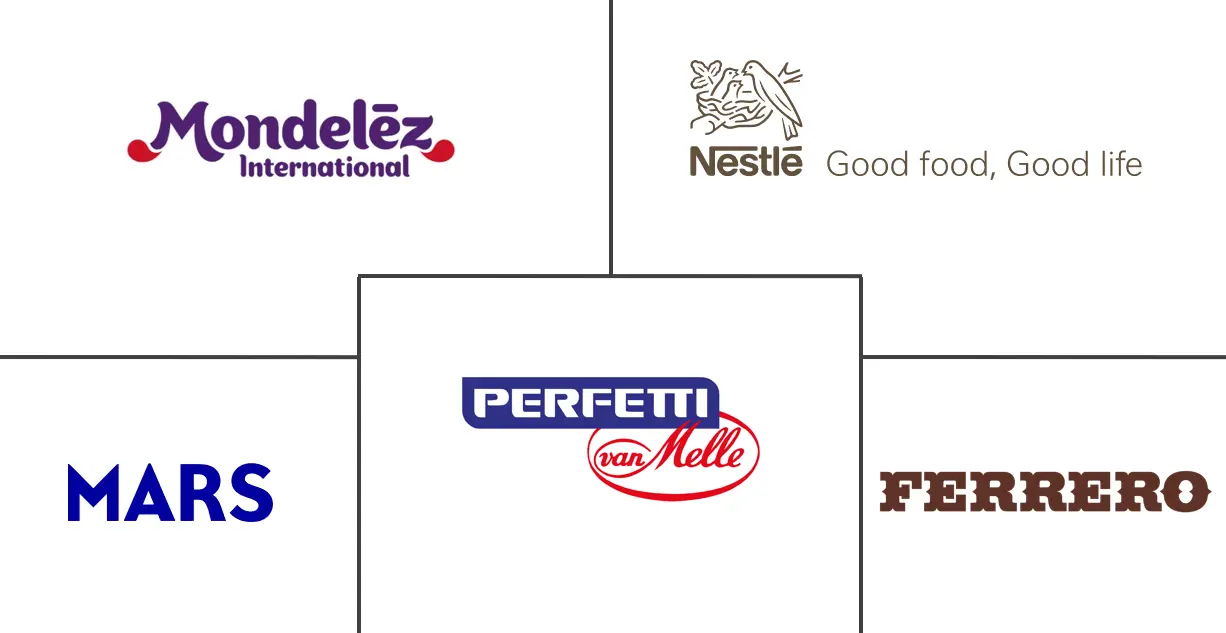Mints Market Size and Share
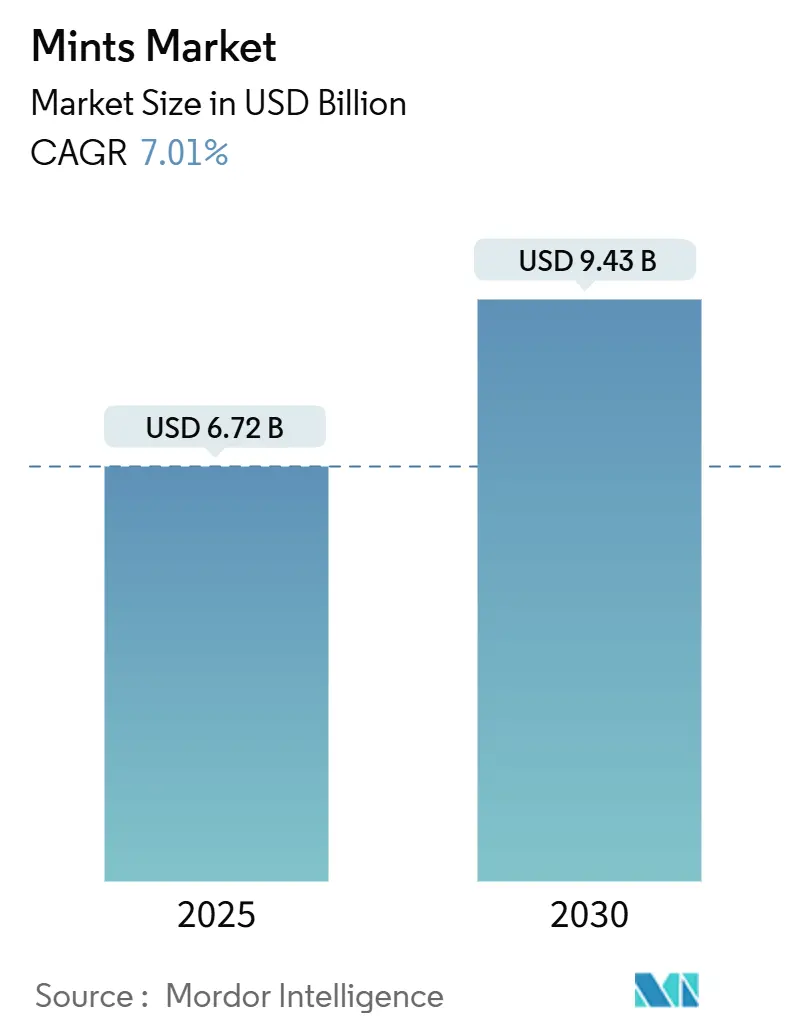
Mints Market Analysis by Mordor Intelligence
By 2025, the mint market size is projected to be valued at USD 6.72 billion, with forecasts indicating a rise to USD 9.43 billion by 2030, marking a steady CAGR of 7.01%. The market's growth trajectory is bolstered by a robust demand for breath-freshening products, an increasing inclination towards functional confectionery, and their heightened availability via online platforms. Distinct value propositions emerge from premium positioning, sugar-free reformulations, and eco-friendly packaging, appealing to a diverse consumer base. While shoppers in mature economies gravitate towards gourmet and organic choices, emerging markets witness volume growth driven by rising disposable incomes and a burgeoning middle class. This moderate fragmentation in the market enables both global giants and nimble regional players to seize new consumption opportunities, intensifying competition and driving relentless innovation in flavors and formats.
Key Report Takeaways
- By product type, Mouth Refreshing Mints held 62.32% of Mint market share in 2024, while Functional Mints are projected to expand at a 6.10% CAGR to 2030.
- By sugar content, Sugar Mints accounted for 65.11% share of the Mint market size in 2024, whereas Sugar-Free Mints are set to advance at a 5.67% CAGR through 2030.
- By flavor, Traditional Mint Flavor controlled 73.42% revenue share in 2024, and Fruity Flavors are expected to post a 6.04% CAGR to 2030.
- By packaging, Flip-top Boxes led with 50.87% revenue share in 2024; Sachets are forecast to record a 5.56% CAGR between 2025 and 2030.
- By distribution channel, Supermarkets/Hypermarkets captured 45.67% revenue share in 2024, while Online Retail Stores are projected to grow at an 8.04% CAGR over the forecast period.
- By geography, North America commanded 35.16% revenue share in 2024, whereas Asia-Pacific is anticipated to rise at a 6.98% CAGR to 2030.
Global Mints Market Trends and Insights
Drivers Impact Analysis
| Drivers | (~) % Impact on CAGR Forecast | Geographic Relevance | Impact Timeline |
|---|---|---|---|
| Growing demand for breath-freshening products is boosting mint confectionery sales. | +1.8% | Global, with higher impact in Asia-Pacific and North America | Medium term (2-4 years) |
| Expansion of online retail enhances accessibility and visibility of mint candies. | +1.2% | Global, particularly strong in developed markets | Short term (≤ 2 years) |
| Innovative flavors and textures are attracting younger and experimental consumers. | +0.9% | North America & EU, expanding to urban Asia-Pacific | Medium term (2-4 years) |
| Premiumization trends fuel interest in gourmet and artisanal mint confections. | +0.7% | North America & EU, selective urban centers in emerging markets | Long term (≥ 4 years) |
| Compact and portable packaging supports on-the-go consumption of mints. | +0.6% | Global, with emphasis on urban centers | Short term (≤ 2 years) |
| Cultural and social habits sustain regular use of mints for oral freshness. | +1.1% | Global, with regional variations in consumption patterns | Long term (≥ 4 years) |
| Source: Mordor Intelligence | |||
Growing demand for breath-freshening products is boosting mint confectionery sales.
The growing demand for breath-freshening products continues to drive the expansion of the mint confectionery market. Consumers, particularly busy professionals, smokers, and individuals who consume alcohol, increasingly rely on mints as a convenient solution to mask odors or as a quick alternative to traditional oral hygiene when time is constrained. Additionally, the rising awareness of health and wellness is pushing buyers toward sugar-free and natural mint options, which are widely regarded as beneficial for dental health and overall well-being. Product innovation plays a pivotal role in sustaining market growth. Manufacturers are introducing new flavors and hybrid mints enriched with functional ingredients such as caffeine or herbal extracts, catering to diverse consumer preferences and enhancing product appeal. The impulse-driven nature of mint purchases, coupled with visually appealing packaging and extensive availability across retail channels, further encourages frequent buying and experimentation with new offerings. These evolving consumer behaviors and preferences are expected to support the steady growth of the global mint confectionery market throughout the forecast period. The market's ability to adapt to changing demands, such as the preference for healthier and multifunctional products, positions it for sustained expansion over the next decade.
Expansion of online retail enhances accessibility and visibility of mint candies.
Food e-commerce has emerged as a significant driver of online sales, accounting for 30% of total online sales in key markets like South Korea. According to the USDA, this segment is witnessing a strong 12% year-on-year growth, reflecting the rapid transformation in consumer purchasing behaviors[1]United States Department of Agriculture, "South Korea Food Ecommerce Market", apps.fas.usda.gov. The digital commerce landscape is reshaping how consumers discover and purchase mint products by offering capabilities that traditional retail channels cannot match. Features such as subscription models and bulk purchasing options address the increasing demand for convenience and cost-effectiveness. Additionally, advanced algorithm-driven recommendations are broadening consumer access to a diverse range of premium and functional mint variants, many of which are unavailable in physical stores. This digital shift is particularly advantageous for smaller, innovative brands that often encounter challenges in traditional retail distribution. By leveraging direct-to-consumer channels, these brands can overcome conventional barriers, gain quicker market entry, and utilize real-time consumer feedback to refine and accelerate their product innovation cycles. This transformation is fostering a more competitive and dynamic market environment, driving sustained growth and innovation across the sector. As digital commerce continues to evolve, it is expected to play a pivotal role in shaping the future of the food e-commerce market.
Innovative flavors and textures are attracting younger and experimental consumers.
Manufacturers are broadening flavor innovations beyond the conventional mint profiles, infusing exotic botanicals and functional ingredients. This strategy aims to captivate younger demographics in search of distinctive sensory experiences. Such a pivot resonates with the rising consumer appetite for diverse and refined taste options, where an array of choices signals product quality and brand ingenuity. Notably, Millennials and Generation Z are steering this trend, emphasizing experiential consumption. They gravitate towards brands showcasing innovative flavors, often sidelining those anchored in traditional brand loyalty. Data from the US Census Bureau highlights the significance of this demographic shift: in 2024, Millennials emerged as the predominant generation in the U.S., constituting roughly 21.81% of the population[2]United States Census Bureau, "Population and Housing Unit Estimates", www.census.gov. Furthermore, the adoption of natural sweeteners like monk fruit and stevia not only bolsters flavor experimentation but also underscores a health-centric approach, aligning with the rising demand for healthier yet flavorful alternatives.
Premiumization trends fuel interest in gourmet and artisanal mint confections.
Mint products are transitioning from basic confections to premium lifestyle accessories, driven by changing consumer preferences. Shoppers are increasingly willing to pay higher prices for attributes such as organic certification, artisanal production techniques, and sustainable packaging solutions. The USDA's organic flavor certification program, which now includes over 14,000 certified organic flavor products, including mint, highlights the growing emphasis on transparency and quality assurance in flavor sourcing[3]United States Department of Agriculture, "United States Department of Agriculture Agricultural Marketing Service | National Organic Program Document Cover Sheet", www.ams.usda.gov. This trend of premiumization is particularly prominent in developed markets, where higher disposable incomes enable consumers to invest in premium, functional products. In contrast, emerging markets are experiencing selective adoption, primarily in urban areas. Here, premium positioning not only reflects social status but also aligns with a rising focus on health and wellness among urban consumers.
Restraint Impact Analysis
| Restraints | (~) % Impact on CAGR Forecast | Geographic Relevance | Impact Timeline |
|---|---|---|---|
| Growing concerns over sugar intake are limiting traditional mint candy consumption. | -1.4% | Global, particularly acute in developed markets with health awareness | Medium term (2-4 years) |
| Regulatory pressure on food labeling and health claims complicates marketing. | -0.8% | EU & North America primarily, expanding globally | Short term (≤ 2 years) |
| Strong presence of substitute products like chewing gum reduces mint consumption. | -1.1% | Global, with regional preferences varying | Long term (≥ 4 years) |
| Rising environmental concerns discourage use of plastic-heavy mint packaging. | -0.5% | EU & North America leading, Asia-Pacific following | Medium term (2-4 years) |
| Source: Mordor Intelligence | |||
Growing concerns over sugar intake are limiting traditional mint candy consumption.
Growing health consciousness is significantly impacting the consumption of traditional sugar-based mints, as consumers increasingly scrutinize ingredient labels and prioritize products that align with their wellness objectives. The Center for Science in the Public Interest's 2024 report sheds light on regulatory gaps in flavor safety evaluations, emphasizing how the GRAS (Generally Recognized as Safe) loophole enables the inclusion of thousands of flavor chemicals in food products without formal FDA oversight. This lack of stringent regulation, combined with rising awareness of diabetes and obesity, is accelerating the shift toward sugar-free alternatives[4]Center For Science In The Public Interest, "Hidden Ingredients What are 'Flavors' and 'Spices,' and are they Safe?", www.cspinet.org. Consequently, traditional mint manufacturers face mounting pressure to reformulate their offerings with natural sweeteners to meet evolving consumer preferences. Failure to adapt could result in a significant loss of market share to competitors who are strategically positioning themselves with health-focused product innovations.
Strong presence of substitute products like chewing gum reduces mint consumption.
Chewing gum manufacturers are increasingly launching sugar-free formulations that not only offer extended flavor release but also provide added functional benefits, such as oral health support. This strategic shift is intensifying competition with adjacent oral care categories. As the gum market approaches maturity, innovation is pivoting towards sugar-free mints, a segment experiencing significant growth, particularly in Asia. The rapid expansion in this region highlights the rising consumer preference for healthier and more convenient alternatives. However, the threat of substitution extends beyond direct competitors within the mint category. Products such as breath sprays, oral strips, and probiotic lozenges, which deliver similar functional benefits while offering unique consumption experiences, are gaining traction. This diversification is fragmenting the traditional mint market share, distributing it across a broader range of product categories. In response to these challenges, mint manufacturers are shifting their strategies. They are focusing on creating distinct value propositions to differentiate their offerings, rather than relying solely on their historical dominance within the category. This approach aims to address evolving consumer demands and maintain competitiveness in an increasingly crowded market.
Segment Analysis
By Product Type: Mouth Refreshing Mints Dominates and Functional Mints Accelerates
In 2024, Mouth Refreshing Mints hold a dominant 62.32% market share, highlighting their pivotal role in traditional oral hygiene practices and their appeal as an impulse purchase across global markets. This segment's leadership is rooted in consumer trust, driven by its proven ability to provide immediate breath-freshening solutions. These mints are particularly valued in social and professional settings, where maintaining oral hygiene confidence is essential. Furthermore, the segment benefits from well-established distribution networks and strategic point-of-sale placements, which effectively capture consumer attention and drive impulse purchases in retail environments.
Functional Mints set to grow with a projected CAGR of 6.10% through 2030. This growth is propelled by increasing consumer demand for products that offer health benefits beyond basic breath freshening. The segment leverages scientific research supporting the therapeutic properties of mint, particularly peppermint oil, which has demonstrated efficacy in managing irritable bowel syndrome symptoms and its antimicrobial effects on oral microbiomes. These effects include reducing harmful bacteria such as Prevotella, Streptococcus, and Neisseria species. The rise of functional mints aligns with broader health and wellness trends, as consumers increasingly seek products that combine multiple benefits within familiar formats. This positions functional mints as a hybrid offering, bridging the gap between traditional confectionery products and nutraceutical solutions.
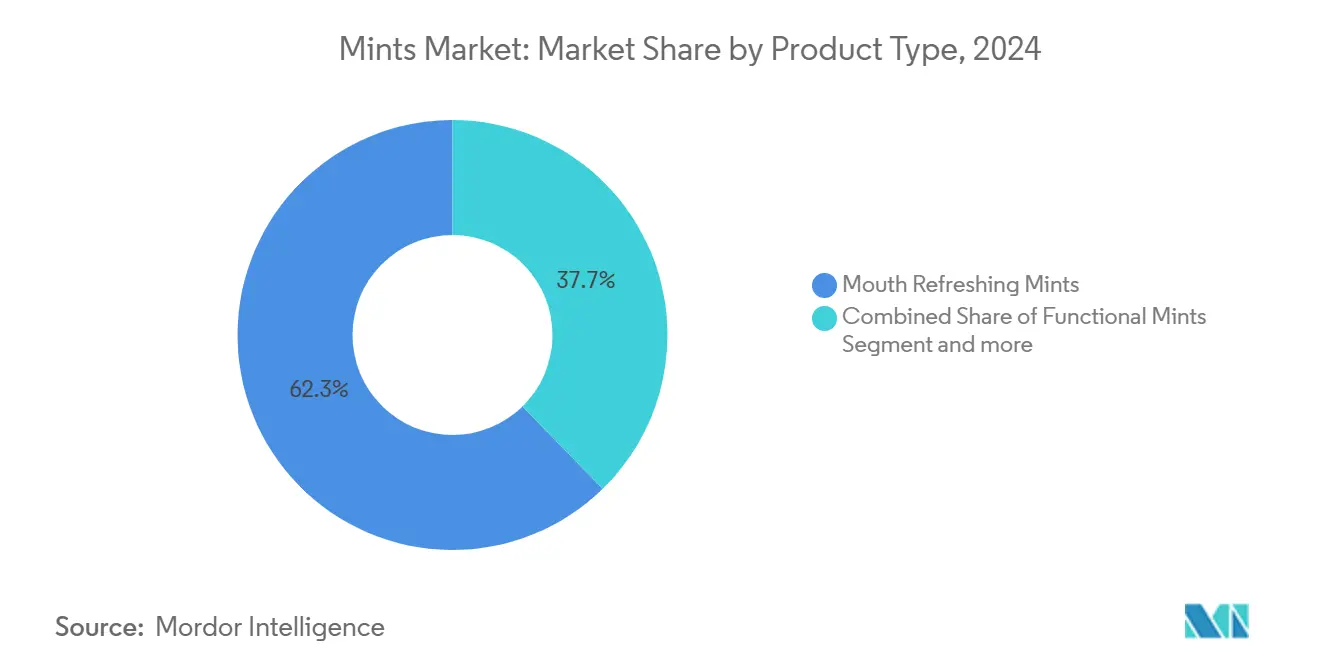
Note: Segment shares of all individual segments available upon report purchase
By Sugar Content: Sugar Mints Dominates where Sugar-Free Mints Accelerates
In 2024, Sugar Mints hold a dominant 65.11% market share, highlighting the sustained popularity of traditional formulations despite increasing health concerns over sugar consumption. This segment's leadership is driven by ingrained consumer taste preferences, affordability, and habitual purchasing patterns, which collectively hinder the rapid adoption of reformulated alternatives. The segment remains particularly robust in emerging markets, where cost considerations often outweigh health-focused positioning, and in traditional retail channels, where impulse purchases tend to favor well-known and trusted products.
Sugar-Free Mints, on the other hand, are propelling category growth with a projected CAGR of 5.67% through 2030, reflecting a gradual but noticeable shift in consumer preferences toward healthier options. This trend is especially evident among diabetic consumers and health-conscious demographics seeking indulgent yet guilt-free alternatives. The growth of sugar-free formulations is supported by advancements in sweetener technologies, such as the use of natural alternatives like monk fruit, which preserve flavor profiles while eliminating caloric content. Furthermore, certifications from organizations like Toothfriendly International, endorsing products such as Vita Pharmed's NotSore range, provide credible third-party validation. These certifications play a crucial role in enhancing consumer confidence and driving the adoption of sugar-free alternatives.
By Flavor: Mint Flavor Dominates and Fruity Flavor Accelerates
In 2024, the mint flavor holds a commanding 73.42% market share, reflecting its strong alignment with consumer preferences and strategic brand positioning centered on delivering authentic mint experiences with reliable breath-freshening efficacy. This segment's dominance is attributed to deeply ingrained consumer associations between mint and oral hygiene benefits, reinforced by decades of targeted marketing and widespread cultural acceptance across global markets. Furthermore, the production of traditional mint flavoring remains cost-effective, supported by robust and well-established supply chain networks, which further solidify its market leadership.
Fruity flavors are projected to grow at a 6.04% CAGR through 2030, driven by increasing demand from younger demographics seeking diverse and innovative taste experiences that go beyond traditional mint profiles. This growth aligns with a broader trend in the confectionery market, where offering a variety of flavors is perceived as a marker of product sophistication and brand creativity. Advances in sweetener and flavor technologies, such as rubusoside and steviol glycosides, have enabled manufacturers to develop complex and appealing flavor profiles without compromising health-conscious positioning. This shift toward flavor diversification resonates strongly with millennials and Generation Z, who prioritize unique and experiential consumption over conventional brand loyalty, further fueling the segment's expansion.
By Packaging: Flip-top Box Dominates and Sachets Accelerates
In 2024, Flip-top Box packaging holds a commanding 50.87% market share, driven by its ability to combine consumer convenience with robust product protection. This packaging format plays a pivotal role in supporting premium product positioning and fostering repeat purchase behavior. Its dominance is attributed to features such as maintaining product freshness, enabling precise portion control, and creating a distinctive shelf presence that enhances brand differentiation. The flip-top format is particularly appealing to consumers who value convenient access while ensuring the product's integrity across multiple consumption occasions, making it a preferred choice in the market.
Sachets are positioned as the fastest-growing packaging format, with a projected CAGR of 5.56% through 2030. This growth is propelled by increasing consumer preferences for portion control and a heightened focus on environmental sustainability. The rising demand for sachets reflects a shift in consumer priorities, where reducing packaging waste significantly influences purchasing decisions, especially among environmentally conscious demographics. Additionally, the evolution of sachet packaging aligns with global regulatory trends aimed at minimizing plastic usage. Over 45 countries are actively implementing or drafting new packaging standards, including bans on single-use plastics and mandates for minimum recycled content, further driving the adoption of sustainable packaging solutions.
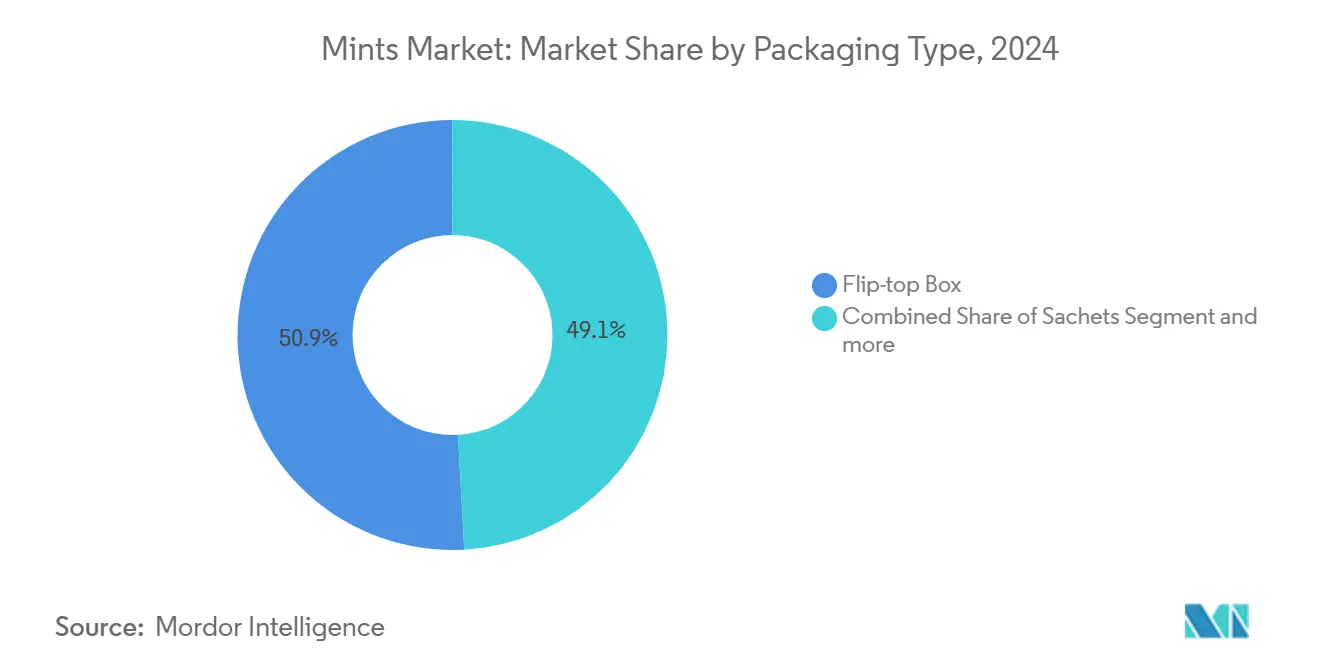
Note: Segment shares of all individual segments available upon report purchase
By Distribution Channel: Supermarkets/Hypermarkets Dominates and Online Retail Stores Accelerates
In 2024, Supermarkets and Hypermarkets maintain a dominant 45.67% market share, driven by their ability to integrate impulse buying seamlessly with routine shopping patterns. These channels benefit from established relationships with traditional retailers, strategic product placements near checkout counters, and consumer familiarity with store layouts, particularly for mint products. Additionally, cross-merchandising strategies and targeted promotional campaigns significantly contribute to incremental sales growth. By aligning these factors strategically, Supermarkets and Hypermarkets continue to reinforce their leadership position in the market, offering a comprehensive shopping experience that caters to diverse consumer needs.
Online Retail Stores are projected to grow at a robust CAGR of 8.04% through 2030, reflecting the transformative influence of digital commerce on consumer purchasing behaviors. The pandemic has accelerated the adoption of online grocery shopping, with convenience, personalized subscription models, and enhanced accessibility reshaping consumption patterns. This channel is particularly well-suited for premium and functional mint products, which often require detailed product information and consumer education. Unlike traditional retail, online platforms provide an opportunity to engage consumers with tailored content, fostering informed purchasing decisions and driving growth in these specialized segments.
Geography Analysis
In 2024, North America commands a 35.16% share of the global mint market, underscoring its consumers' long-standing commitment to oral hygiene and a retail landscape adept at promoting premium products. This regional leadership is bolstered by high disposable incomes, a pronounced health consciousness, and a cultural inclination towards functional foods that offer wellness advantages beyond mere nutrition. While traditional mint consumption persists, there's a notable shift towards organic and natural products, a trend validated by USDA organic certifications ensuring quality and transparency in sourcing. Moreover, the region's intricate regulatory landscape offers clear guidelines for product development and marketing claims, fostering innovation within set boundaries.
Asia-Pacific is on track to be the fastest-growing region, boasting a projected CAGR of 6.98% through 2030. This growth is fueled by a burgeoning middle class, heightened awareness of oral hygiene, and the cultural embedding of mint in daily practices. Urban centers, in particular, are witnessing a surge in demand for convenient oral care products, spurred by an accelerated adoption of Western lifestyles. Companies like Asahi Group Holdings are capitalizing on this trend, with offerings such as MINTIA mint tablets, showcasing their adeptness at merging global mint concepts with local tastes and distribution methods.
Europe, South America, and the Middle East & Africa stand as notable players in the mint market, albeit with a more tempered growth trajectory. These regions present a dual-edged sword for mint manufacturers: a tapestry of diverse cultural preferences and a maze of regulatory intricacies. European markets, for instance, place a premium on sustainability and organic certifications. The EU's stringent spice market regulations, emphasizing food safety, traceability, and labeling, significantly shape mint product development and marketing approaches. While there's a discernible uptick in the adoption of premium and functional mint products across these regions, growth remains subdued. This is largely attributed to entrenched local preferences and a price sensitivity that curtails the reach of premium products beyond urban locales.
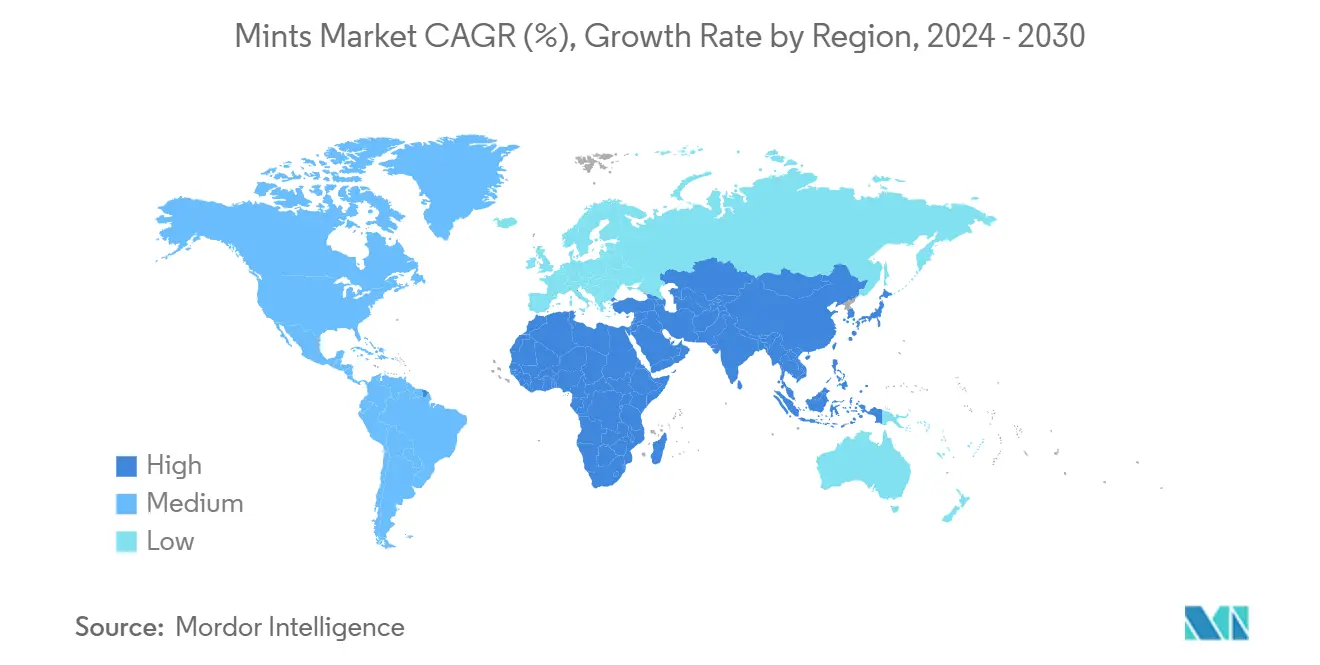
Competitive Landscape
The global mint market is moderately consolidated, characterized by a few dominant players holding significant market shares alongside numerous regional and niche brands. Leading companies such as Ferrero International S.A., Mondelez International, Mars, Incorporated, Perfetti Van Melle Holding B.V., and Nestlé S.A. have leveraged their extensive global distribution networks and strong brand equity to maintain a competitive edge, particularly in the sugar-free and functional mint segments. However, the growing consumer demand for clean-label, organic products, and innovative formats—such as functional mints enriched with probiotics or vitamins—has created opportunities for emerging players to carve out market space.
Despite the dominance of key players, the market remains competitive due to factors like product diversification, the expansion of private labels, and varying regional preferences. This balance between market concentration and fragmentation reinforces its moderately consolidated structure. Competition is particularly intense in areas such as functional ingredients and sustainable packaging, where smaller, agile players often lead innovation. Larger companies frequently adopt these successful concepts through acquisitions or internal development, further driving market evolution.
Strategic initiatives in the market increasingly focus on vertical integration and direct-to-consumer models, enabling companies to enhance quality control, reduce operational costs, and gather valuable consumer data to inform product development. Innovation remains a priority, as evidenced by patent activity in sweetener and flavor compositions. Advances in rubusoside and steviol glycosides have facilitated the creation of sugar-free formulations that retain taste appeal, addressing consumer preferences for healthier options. Additionally, significant growth opportunities exist in the functional mint segment, particularly in emerging markets. Rising disposable incomes and increasing health consciousness in these regions are accelerating the adoption of premium products, especially those positioned to deliver oral health benefits alongside broader wellness advantages.
Mints Industry Leaders
-
Ferrero International S.A.
-
Mondelez International
-
Mars, Incorporated
-
Perfetti Van Melle Holding B.V.
-
Nestlé SA
- *Disclaimer: Major Players sorted in no particular order
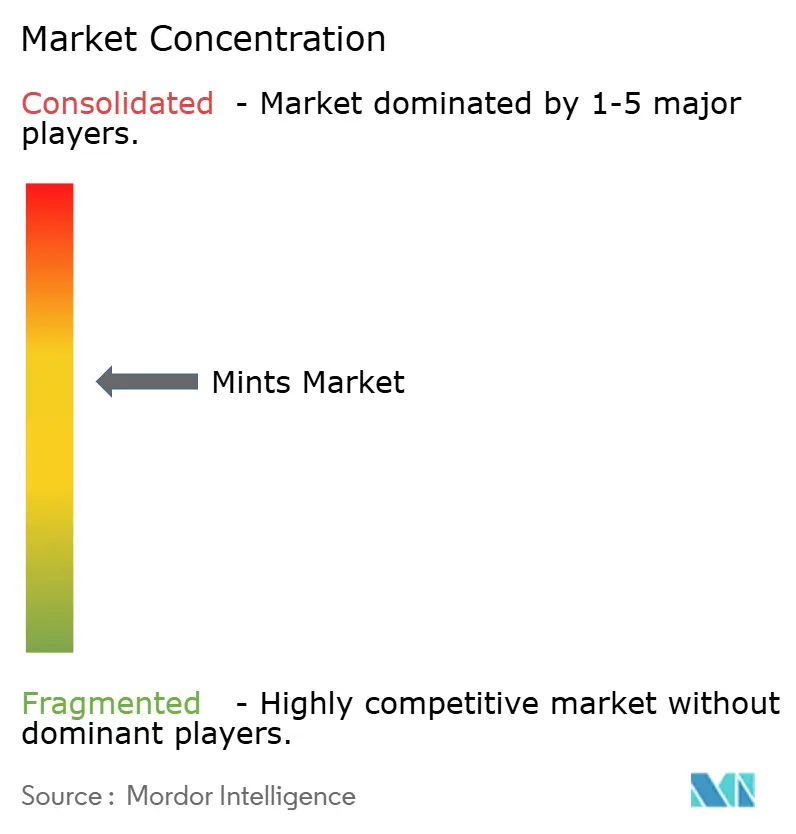
Recent Industry Developments
- May 2025: Certs mints and gum relaunched in stores in 2025 through a partnership between Nature’s Stance and the brand's owners as part of its expansion. The brand aims to bring back classic flavors while also introducing new products, intending to appeal to both longtime fans and new customers.
- April 2025: Mars Wrigley has invested USD 6.5 million in a new production line at its Asquith, NSW facility to boost its gum and mints output by over 60%. This expansion is expected to increase supply for both domestic and export markets, supporting the company’s growth in the confectionery sector.
- March 2025: Tic Tac has launched Tic Tac Two, a new sugar-free, dual-flavour mint that is twice the size of the original and features two distinct layers for a contrasting taste. The range debuts globally with Raspberry & Lemon, Strawberry & Lime, and Fresh & Mild Spearmint, aiming to attract adventurous consumers with bold and playful combinations.
- January 2024: IMPACT MINTS has officially launched in Australia, introducing special Kakao Friends-themed IMPACT MINTS alongside the new Slim Slide IMPACT MINTS. According to the brand, the debut features collectible packaging with popular Kakao Friends characters, aiming to attract both mint lovers and fans of the Korean pop culture icons.
Global Mints Market Report Scope
Mints are food products that are consumed as breath refreshment candies. The report's scope for the mint market includes product type, in which the market is segmented into power mints and standard mints. By distribution channel, the market is segmented into supermarkets/hypermarkets, convenience stores, pharmacies, specialist retailers, and other distribution channels. By geography, the market is segmented into North America, Europe, Asia-Pacific, South America, the Middle East, and Africa. For each segment, the market sizing and forecasts have been done based on value (in USD million).
| Functional Mints |
| Mouth Refreshing Mints |
| Others |
| Sugar Mints |
| Sugar -Free Mints |
| Mint Flavor |
| Fruity Flavors |
| Others |
| Flip-top box |
| Rolls/tubes |
| Sachets |
| Others |
| Supermarkets /Hypermarkets |
| Convenience/Grocery Stores |
| Online Retail Stores |
| Other Distribution Channels |
| North America | United States |
| Canada | |
| Mexico | |
| Rest of North America | |
| Europe | Germany |
| United Kingdom | |
| Italy | |
| France | |
| Spain | |
| Netherlands | |
| Poland | |
| Belgium | |
| Sweden | |
| Rest of Europe | |
| Asia-Pacific | China |
| India | |
| Japan | |
| Australia | |
| Indonesia | |
| South Korea | |
| Thailand | |
| Singapore | |
| Rest of Asia-Pacific | |
| South America | Brazil |
| Argentina | |
| Colombia | |
| Chile | |
| Peru | |
| Rest of South America | |
| Middle East and Africa | South Africa |
| Saudi Arabia | |
| United Arab Emirates | |
| Nigeria | |
| Egypt | |
| Morocco | |
| Turkey | |
| Rest of Middle East and Africa |
| By Product Type | Functional Mints | |
| Mouth Refreshing Mints | ||
| Others | ||
| By Sugar Content | Sugar Mints | |
| Sugar -Free Mints | ||
| By Flavor | Mint Flavor | |
| Fruity Flavors | ||
| Others | ||
| By Packaging | Flip-top box | |
| Rolls/tubes | ||
| Sachets | ||
| Others | ||
| By Distribution Channel | Supermarkets /Hypermarkets | |
| Convenience/Grocery Stores | ||
| Online Retail Stores | ||
| Other Distribution Channels | ||
| By Geography | North America | United States |
| Canada | ||
| Mexico | ||
| Rest of North America | ||
| Europe | Germany | |
| United Kingdom | ||
| Italy | ||
| France | ||
| Spain | ||
| Netherlands | ||
| Poland | ||
| Belgium | ||
| Sweden | ||
| Rest of Europe | ||
| Asia-Pacific | China | |
| India | ||
| Japan | ||
| Australia | ||
| Indonesia | ||
| South Korea | ||
| Thailand | ||
| Singapore | ||
| Rest of Asia-Pacific | ||
| South America | Brazil | |
| Argentina | ||
| Colombia | ||
| Chile | ||
| Peru | ||
| Rest of South America | ||
| Middle East and Africa | South Africa | |
| Saudi Arabia | ||
| United Arab Emirates | ||
| Nigeria | ||
| Egypt | ||
| Morocco | ||
| Turkey | ||
| Rest of Middle East and Africa | ||
Key Questions Answered in the Report
What is the current size of the global mint market?
The market stands at USD 6.72 billion in 2025.
How fast is the global mint market expected to grow?
It is projected to expand at a 7.01% CAGR and reach USD 9.43 billion by 2030.
Which product segment is growing the quickest?
Functional mints lead growth with a forecast 6.10% CAGR through 2030, fueled by added health benefits.
Which region shows the highest growth potential?
Asia-Pacific is the fastest-growing region, projected to register a 6.98% CAGR to 2030, driven by expanding middle-class populations and strong online retail uptake.
Page last updated on:
